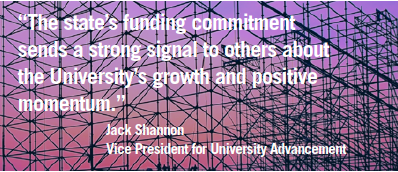Investing in the Future
 by David Chmiel
by David Chmiel
Educators have one mandate: Give students the tools they need to succeed in the classroom and the professional world. Administrators have an even more challenging task: Find ways to fund and deliver those tools.
Administrators at Montclair State will use a relatively simple tool – the shovel – to accomplish both goals when they break ground this fall on a Center for Environmental and Life Sciences and a new School of Business building, becoming the first school to start construction. The $121-million construction projects were made possible when the state of New Jersey designated nearly $94 million in bonds to the University to help finance the construction as well as enhancements to the campus technology infrastructure.
Montclair State made such a strong case for its projects that it was awarded more money than any other senior public or private institution – with The College of New Jersey getting the next highest amount, $57 million. Only public research universities received more.
University President Susan A. Cole notes, “This substantial and catalytic investment by the state will greatly benefit both New Jersey’s students and the economy by building upon critical areas of expertise and excellence that reside in our strong, high-demand programs in the sciences and business.”
The new construction ends a 25-year drought for state-funded capital-improvement projects at New Jersey colleges and universities. The change came last November, when more than two-thirds of voters approved the $750- million “Building Our Future” Bond Act, a construction-and-modernization package for academic and research centers. In all, $1.3 billion will be spent by the state on 176 projects to upgrade facilities at 46 of New Jersey’s two-year and four-year colleges and universities.
In announcing the list of projects, New Jersey Governor Chris Christie said that the capital improvements would keep state colleges competitive, retain the best students and “make our colleges more attractive research partners for industries looking to bring good-paying jobs and businesses here.”
Capital improvements such as these are “essential to the future of Montclair State and all of New Jersey’s great institutions of higher learning,” Cole notes. “With this program, the state has taken a giant step forward to ensure that we continue to meet the demands of New Jersey’s educational future.”
In support of science
 “This change has been a long time coming,” says Robert Prezant, dean of the College of Science and Mathematics, who has seen enrollment more than double during his 15-year tenure at Montclair State. “We’ve been planning the new building for seven or eight years, ever since we began to outgrow our space. This was an imperative for us, our students, our faculty and our growing list of research partners.”
“This change has been a long time coming,” says Robert Prezant, dean of the College of Science and Mathematics, who has seen enrollment more than double during his 15-year tenure at Montclair State. “We’ve been planning the new building for seven or eight years, ever since we began to outgrow our space. This was an imperative for us, our students, our faculty and our growing list of research partners.”
The $55-million, 107,500-square-foot Center for Environmental and Life Sciences will expand the University’s science and research infrastructure by 50 percent. The building will include state-of-the-art classrooms and research labs to keep pace with rapidly growing programs in environmental sustainability, pharmaceutical biochemistry and medicinal chemistry. In addition, the building will house a 150-seat lecture hall, a microscopy suite and space to grow the classroom and research needs for biological, computing and mathematical sciences.
“A major investment in the new facility, and indeed, in the commitment to STEM [science, technology, engineering and mathematics] education at Montclair State is vital for New Jersey and the economic engine of the sustainability, biotechnology, environmental science and health sectors,” Prezant notes. “It represents support for tomorrow’s professionals who will move the state forward.”
 Good for business
Good for business
The $66-million School of Business building will be a 143,000-square-foot structure featuring high-tech classrooms and seminar rooms, a 150-seat lecture hall and computer labs, along with market research/analysis labs and a financial-trading floor. The new facility, which will replace the 40-year-old Partridge Hall as the School’s home, also will serve as the hub for the Feliciano Center for Entrepreneurship and the Institute for Corporate Social Responsibility.
E. LaBrent Chrite, dean of the School of Business, is especially excited about having the space to accommodate executive meetings for regional and global collaborations with the state’s business community. “The state of New Jersey has provided a wonderful boost for the School and its many stakeholders,” he says. “With the new School of Business building, Montclair State will be ideally positioned to serve the citizens of New Jersey and the surrounding region.
“The additional students drawn to the University by the new facility will have a significant impact on the future of the New Jersey business community,” Chrite adds. “The impact will be dramatic and real. We prepare students who will create value for public- and private-sector entities in New Jersey and the region. Increasingly, we are also preparing students for the opportunities and the rigors of business ownership through our entrepreneurship program.”
The projects also will present an economic boon for the area during the construction phase, creating 1,500 construction and support jobs for the duration of the projects and bringing in numerous workers who will support local businesses during their workday.
Paying it forward
John T. “Jack” Shannon, vice president for University Advancement, says the $94 million from the state will help the University leverage the additional $50 million in non-state funding needed to offset construction costs as well as to prepare for other campus-wide enhancements.
 “There was a collaborative effort by the president, the provost, the deans and nearly every department in the University to secure state funding,” he says. “Now that we have resources from the state, we can ramp up our efforts to engage with alumni, friends of the University, foundations and corporations that have supported us in the past and are interested in investing in our growth.
“There was a collaborative effort by the president, the provost, the deans and nearly every department in the University to secure state funding,” he says. “Now that we have resources from the state, we can ramp up our efforts to engage with alumni, friends of the University, foundations and corporations that have supported us in the past and are interested in investing in our growth.
“The state’s funding commitment sends a strong signal to others about the University’s growth and positive momentum,” Shannon adds. “With the leadership of the governor and the legislature, the state has fulfilled a key role as lead donor for the project. The state’s investment allows us to now leverage our limited bonding capacity for other critical initiatives such as the planned new home for the School of Communication and Media that are equally important to helping Montclair State deliver the very best education to all of our students.”
Fighting brain drain
According to recent statistics, New Jersey loses roughly 28,000 students each year to universities across the country. The “Building Our Future” bond resources are an attempt to stem this “brain drain” by improving educational opportunities at home.
The governor touts the construction projects as a major step toward retaining in-state students. “The correlation between the ability to get a job, a higher income and educational attainment is clear,” Christie announced last spring. “So let’s make the path to college available to every New Jerseyan who’s willing to do the work to get there.”
Chrite says the projects will help Montclair State retain local talent, and might lure out-of-state students. “We absolutely believe that we can much more effectively compete for out-of-state students,” he says. “Initially, I know the University is trying to attract students from a wider segment of New Jersey. We’d like to have more students from South Jersey, for example. With the new residence halls on campus, and the new facility for the school, we believe we’ll be able to compete with any school in the state for out-of-state students.
While our commitment obviously remains to the citizens of New Jersey, we’re anxious to compete for a wider cohort of students as well,” Chrite says.
Prezant is quick to point out that the job of paying for the projects isn’t yet finished. “We remain in fundraising mode,” he says. “This funding doesn’t cover the total cost of the projects. When that shovel goes into the ground, this mission of ours to grow the college will become true in a very real way. It will help the students and faculty, and will play a big part in helping us find new ways to grow our relationships with the corporate partners who have been so supportive of our programs to this point.”
Cole warns that New Jersey cannot afford to ever again fall behind in committing to funding higher education at the necessary levels. “Would anyone seriously argue that Montclair State University, or any New Jersey school for that matter, should have turned away the tens of thousands more students seeking an education or could so substantially have increased the number of well-educated graduates without any increase in the academic and research facilities to do so?”
Montclair State is turning a $94-million windfall into a source of pride for students, faculty, administrators and alumni – and the catalyst for growth in the University’s reputation. “These projects herald a new era for Montclair State,” Cole says. “and for higher education in New Jersey.”
